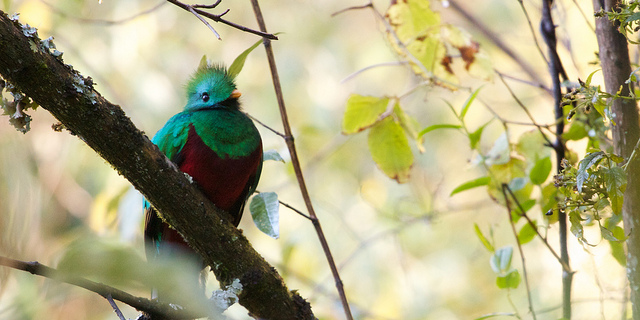South of Cartago, the Pan-American Highway (Hwy. 2) begins a daunting ascent over the Talamanca Mountains, cresting the range at Cerro de la Muerte (Mountain of Death) at 3,491 meters (11,453 feet) before dropping down into the Valle de El General and the Pacific southwest. The vistas are staggering, and opportunities abound for hiking, trout fishing, and bird-watching—notably for resplendent quetzals, which are common hereabouts (especially Nov.-Mar.). The region is clad in native oak and cloud forest, and the climate is brisk.

View from Mirador de Quetzales, also known as Finca Eddy Serrano. Photo ©
Drive carefully! The road is often fog-bound, and it’s best to head out early to mid-morning, before the clouds roll in. It also zigzags with sudden hairpin turns, is washed out in places, and is used by buses and trailer rigs driven by crazy people. In 2010 the Association for Safe International Road Travel named this the fourth most dangerous section of road in the world.
At Enpalme, 30 kilometers (19 miles) south of Cartago, a side road descends in a series of spectacular switchbacks to Santa María de Dota; while at Vara de Roble (2 kilometers/1.2 miles north of Enpalme), another road—known as Ruta de Los Santos (Route of the Saints)—leads west to San Cristóbal via La Lucha Sin Fin. You can also reach Santa María de Dota from Cañón, five kilometers (3 miles) south of Enpalme at Kilometer 58 via a dirt road that descends steeply to Copey. Copey is a small agricultural village at about 2,120 meters (6,960 feet), eight kilometers (5 miles) southwest of Cañón and five kilometers (3 miles) east of Santa María de Dota.

The resplendent quetzal is common in the area. Photo © Matt MacGillivray, licensed Creative Commons Attribution.
At Trinidad, five kilometers (3 miles) south of Cañón, you pass through the Parque Nacional Tapantí-Macizo de la Muerte. The Cuenca Queberi Trail, which begins at Kilometer 61, leads into the reserve.
At Kilometer 70, a side road leads to Mirador de Quetzales (tel. 506/2381-8456, 8am-5pm daily, $6 for trail access), aka Finca Eddy Serrano, the perfect spot for viewing quetzals. Up to 20 pairs of quetzals have been seen feeding in treetops near the finca. Serrano leads guided quetzal hikes for hotel guests (6:30am-4pm daily, $15 pp), and the Robledal Oak Forest Trail is open to self-guided hikes with a map and illustrated booklet.
Finally, at Kilometer 89 you crest Cerro de la Muerte. The name derives not from the dozens who have lost their lives through auto accidents, but from the many poor campesinos who froze to death in days of yore while carrying sacks of produce to trade in San José. The summit is marked by a forest of radio antennae. A dirt road leads up to the antennae, from where you’ll have miraculous views, weather permitting. At 3,000 meters (9,800 feet) the stunted vegetation is Andean páramo, complete with wind-sculpted shrubs, peat bogs, and marshy grasses. Be prepared for high winds.
At Kilometer 70 on the Pan-American Highway you’ll find Albergue Mirador de Quetzales (tel. 506/2381-8456, $50 pp, includes meals and tour), at Finca Eddy Serrano. This rustic yet cozy lodge is set amid cloud forest at 2,600 meters (8,500 feet) where quetzals congregate to nest. There are 11 A-frame log cabins boasting marvelous views, all with one double and one single bed and a private bath with hot water. You can camp ($6 pp) under thatched roofs with tables and barbecue grills. Rates include three meals daily and a quetzal tour. The same family runs the adjoining Paraíso del Quetzal (tel. 506/2390-7894, 7am-8:30pm daily, $2-10), serving comida típica.
The San Isidro bus departs San José from Calle Central, Avenida 22, and will drop you or pick you up anywhere along Highway 2. Most hotel owners will pick you up at the bus stop on the highway with advance notice. There’s a gas station at Enpalme.
Excerpted from the Ninth Edition of Moon Costa Rica.